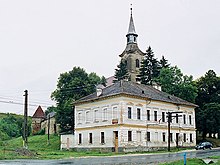Șaeș
|
Șaeș Schaas Segesd |
||||
|
||||
| Basic data | ||||
|---|---|---|---|---|
| State : |
|
|||
| Historical region : | Transylvania | |||
| Circle : | Mureș | |||
| Municipality : | Apold | |||
| Coordinates : | 46 ° 9 ' N , 24 ° 46' E | |||
| Time zone : | EET ( UTC +2) | |||
| Height : | 411 m | |||
| Residents : | 1,196 (2002) | |||
| Postal code : | 547042 | |||
| Telephone code : | (+40) 02 65 | |||
| License plate : | MS | |||
| Structure and administration | ||||
| Community type : | Village | |||
Șaeș (outdated Șaieș, Șaeșiu ; German Schaas or Schees , Hungarian Segesd ) is a village in the Transylvania region in Romania . Administratively it belongs to the municipality of Apold (Trappold) .
Geographical location

Șaeş is about seven kilometers south of Sighişoara (Schäßburg) on the county road (Drum județean) DJ 106, which then leads via Apold (seat of the municipal administration) and the Harbachtal to Sibiu .
history
The village was first mentioned in a document in 1302. Due to the geographical proximity, the events in Schaas were mostly closely connected to those in Schäßburg over the centuries.
Until the 1960s, the narrow-gauge line " Wusch " led through Șaeș and connected the place with the CFR railway network .
population
The population in Șaeș developed as follows:
| census | Ethnic composition | ||||
|---|---|---|---|---|---|
| year | population | Romanians | Hungary | German | other |
| 1850 | 1.004 | 240 | - | 563 | 201 |
| 1941 | 1,371 | 364 | 5 | 685 | 317 |
| 1977 | 1,370 | 317 | 8th | 512 | 533 |
| 1992 | 1,112 | 861 | 14th | 82 | 155 |
| 2002 | 1,196 | 1,117 | 19th | 10 | 50 |
Since 1850, Einwohneraeş had the highest population and that of the Romanian Germans in 1941. The highest number of Romanians was registered in 2002, that of Magyars (24) in 1900 and that of Roma in 1977.
Personalities
- Josef Haltrich (1822–1886), Transylvanian-Saxon folklorist, died in Schaas
Attractions
- The Evangelical Church is mentioned in a document in 1347. At the beginning of the 1500s, the church was expanded into a fortified church , surrounded by a defensive wall and towers. In 1802 the church vault collapsed, so that the church was demolished in 1818 and the current one was built between 1820 and 1832. The fortified church is a listed building.
- The orthodox church Schimbarea la Față built from 1805 to 1821 and the former stop of the Wusch , built in the 19th century, are listed.
See also
Web links
Individual evidence
- ↑ a b Heinz Heltmann, Gustav Servatius (Ed.): Travel Guide Siebenbürgen . Kraft, Würzburg 1993, ISBN 3-8083-2019-2 .
- ↑ Censuses 1850–2002, last updated November 2, 2008 (PDF; 1 MB; Hungarian).
- ↑ a b List of historical monuments of the Romanian Ministry of Culture, updated 2015 (PDF; 12.7 MB; Romanian).


